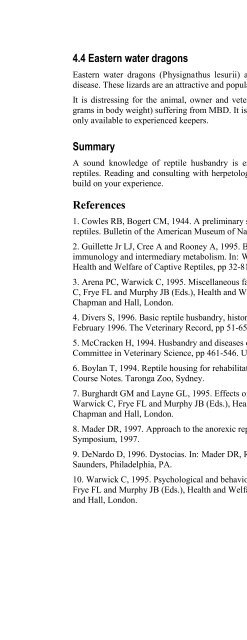Handling and Nursing Reptiles - Australian Veterinary Association
Handling and Nursing Reptiles - Australian Veterinary Association
Handling and Nursing Reptiles - Australian Veterinary Association
You also want an ePaper? Increase the reach of your titles
YUMPU automatically turns print PDFs into web optimized ePapers that Google loves.
4.4 Eastern water dragons<br />
Eastern water dragons (Physignathus lesurii) are overrepresented in cases of metabolic bone<br />
disease. These lizards are an attractive <strong>and</strong> popular pet for the novice reptile keeper.<br />
It is distressing for the animal, owner <strong>and</strong> veterinarian to see small lizards (often less than 10<br />
grams in body weight) suffering from MBD. It is timely that these reptiles were “reclassified” <strong>and</strong><br />
only available to experienced keepers.<br />
Summary<br />
A sound knowledge of reptile husb<strong>and</strong>ry is essential in order to diagnose <strong>and</strong> treat captive<br />
reptiles. Reading <strong>and</strong> consulting with herpetologists <strong>and</strong> reptile veterinarians will enable you to<br />
build on your experience.<br />
References<br />
1. Cowles RB, Bogert CM, 1944. A preliminary study of the thermal requirements of desert<br />
reptiles. Bulletin of the American Museum of Natural History, 83: pp 256-296.<br />
2. Guillette Jr LJ, Cree A <strong>and</strong> Rooney A, 1995. Biology of stress: interactions with reproduction,<br />
immunology <strong>and</strong> intermediary metabolism. In: Warwick C, Frye FL <strong>and</strong> Murphy JB (Eds.),<br />
Health <strong>and</strong> Welfare of Captive <strong>Reptiles</strong>, pp 32-81. Chapman <strong>and</strong> Hall, London.<br />
3. Arena PC, Warwick C, 1995. Miscellaneous factors affecting health <strong>and</strong> welfare. In: Warwick<br />
C, Frye FL <strong>and</strong> Murphy JB (Eds.), Health <strong>and</strong> Welfare of Captive <strong>Reptiles</strong>, pp 262- 283.<br />
Chapman <strong>and</strong> Hall, London.<br />
4. Divers S, 1996. Basic reptile husb<strong>and</strong>ry, history taking <strong>and</strong> clinical examination. In Practice,<br />
February 1996. The <strong>Veterinary</strong> Record, pp 51-65.<br />
5. McCracken H, 1994. Husb<strong>and</strong>ry <strong>and</strong> diseases of captive reptiles. In: Wildlife. Post Graduate<br />
Committee in <strong>Veterinary</strong> Science, pp 461-546. University of Sydney, Sydney.<br />
6. Boylan T, 1994. Reptile housing for rehabilitation. In: Wildlife Rehabilitation – <strong>Reptiles</strong>.<br />
Course Notes. Taronga Zoo, Sydney.<br />
7. Burghardt GM <strong>and</strong> Layne GL, 1995. Effects of ontogenic processes <strong>and</strong> rearing conditions. In:<br />
Warwick C, Frye FL <strong>and</strong> Murphy JB (Eds.), Health <strong>and</strong> Welfare of Captive <strong>Reptiles</strong>, pp 165-185.<br />
Chapman <strong>and</strong> Hall, London.<br />
8. Mader DR, 1997. Approach to the anorexic reptile. In: Proceedings of the 21 st Waltham/OSU<br />
Symposium, 1997.<br />
9. DeNardo D, 1996. Dystocias. In: Mader DR, Reptile Medicine <strong>and</strong> Surgery, pp 370-374.<br />
Saunders, Philadelphia, PA.<br />
10. Warwick C, 1995. Psychological <strong>and</strong> behavioural principles <strong>and</strong> problems. In: Warwick C,<br />
Frye FL <strong>and</strong> Murphy JB (Eds.), Health <strong>and</strong> Welfare of Captive <strong>Reptiles</strong>, pp 205-235. Chapman<br />
<strong>and</strong> Hall, London.

















